Physical Address
304 North Cardinal St.
Dorchester Center, MA 02124
Neonatal acne (acne neonatorum) is a very common newborn eruption, occurring in up to 20% of healthy babies. Lesions are not present at birth but typically appear within the first 2–3 weeks of life and generally improve by about 4 months of age. Small inflammatory red-pink papules and pustules predominate, occurring symmetrically on the cheeks ( Fig. 25.1 ). The forehead, chin, eyelids, scalp, neck, back and chest can be affected as well ( Fig. 25.2 ). Open comedones and nodules are rarely evident, and if present, suggest the possibility of true acne vulgaris, which should be treated according to infantile acne recommendations (see below).
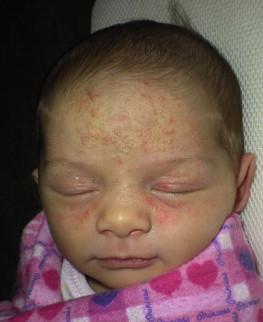
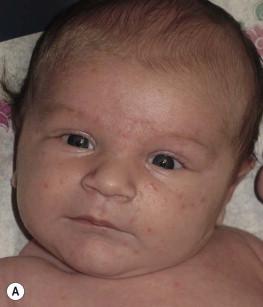
The diagnosis of neonatal acne is usually made clinically. Giemsa staining of pustule contents reveals neutrophils and variable yeast spores. The term ‘neonatal cephalic pustulosis’ (NCP) was proposed to help differentiate this common neonatal eruption from true acne. In contrast to the androgen-driven infantile acne vulgaris, the pathogenesis of neonatal acne is unclear. Increased sebum and the presence of yeast flora have been implicated as possible triggers. It is known that newborn sebum excretion rates correlate with maternal sebum excretion rates perinatally and these levels subsequently decrease over the next several weeks. This suggests that both mother and baby are subject to the same hormonal stimulus following birth. Along with these changes, the baby begins to undergo colonization of normal flora. Malassezia furfur , M. sympodialis and other species frequently colonize neonatal skin, with prevalence rates of 35–50% at 1 week of age and increasing with age, peaking at around 90% by 3–6 months of age. However, Malassezia species are not uniformly cultured from the pustules of neonatal acne nor does the degree of colonization appear to correlate with severity of the clinical findings. Hence, the role of yeast in the pathogenesis of neonatal acne remains controversial.
The differential diagnosis of acneiform lesions in the neonatal and infantile period is broad ( Box 25.1 ). More florid cases of neonatal acne are sometimes indistinguishable from seborrheic dermatitis, very early onset atopic dermatitis, miliaria rubra and in rare instances, congenital candidiasis. In atypical cases, serial follow-up and close scrutiny for lesions on other body sites is recommended. The condition is self-limited and treatment is rarely required. However, in pronounced cases, topical imidazoles, such as clotrimazole or ketoconazole cream, or a low potency topical corticosteroid, such as hydrocortisone 1% cream, may be helpful in accelerating resolution.
Neonatal acne (neonatal cephalic pustulosis)
Infantile acne
Periorificial dermatitis
Childhood rosacea
Milia
Sebaceous hyperplasia
Miliaria
Keratosis pilaris
Pseudoacne of the nasal crease
Seborrheic dermatitis
Disseminated congenital comedones
Eosinophilic folliculitis
Behçet disease
Acneiform follicular mucinosis
Steatocystoma multiplex
Eruptive vellus hair cysts
Trichodysplasia spinulosa
Demodicosis
Molluscum contagiosum
Pustular leukemoid reaction in Down syndrome
Patau syndrome
SAPHO syndrome
PAPA syndrome
Hyper-IgE syndrome
Lipoid proteinosis
Apert syndrome
Corticosteroids
Bromides
Cyclosporine
Iodides
Chloracne (dioxin)
Vitamins B 1 , B 6 , B 12 , and D 2
Phenobarbital
Phenytoin
Propylthiouracil
Disulfiram
Quinidine
Lithium
Isoniazid
Epidermal growth factor receptor inhibitors
Anabolic steroids
Azathioprine
In contrast to neonatal ‘acne’ – a very common condition – infantile acne vulgaris is relatively uncommon. The age of onset is usually between 6 and 12 months, with most cases resolving by 1–3 years. Boys are more commonly affected than girls. Clinically, it is characterized by classic acne lesions occurring primarily on the cheeks. An admixture of open and closed comedones, alone or with inflammatory papules, pustules and small nodules are seen ( Figs. 25.3 , 25.4 ). Severe forms with deep, suppurative nodules have been reported.
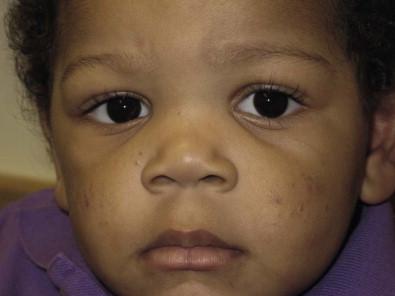
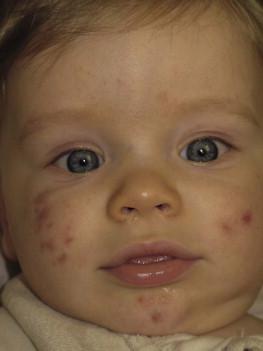
The pathogenesis of infantile acne centers on a physiologic increased production of adrenal and gonadal androgens intrinsic to this stage of development. During the first 6–12 months of life, infant boys have elevated levels of luteinizing hormone with a resultant increased production of testosterone. In addition, the infantile adrenal gland, in both boys and girls, is still immature with an enlarged zona reticularis that produces elevated levels of dehydroepiandrosterone (DHEA). DHEA is subsequently converted by the sebaceous gland into more potent, acne-promoting androgens, like dihydrotestosterone. By 12 months, adrenal androgen levels typically decrease, remaining low until the onset of adrenarche. Testicular androgen production is also minimal throughout childhood. It is important to note that the majority of affected babies do not have an overt pathologic cause of hyperandrogenism and laboratory workup is usually unnecessary. However, a complete hormonal evaluation is indicated in any infant with acne that is unusually severe, persistent, or if the child has other signs of hyperandrogenism or precocious puberty, such as breast development, testicular hypertrophy, penile or clitoral enlargement, or the presence of axillary or pubic hair. Causes of infantile hyperandrogenism are listed in Box 25.2 . The role of genetics in infantile acne is undoubtedly strong with 25–50% of patients reporting a positive family history of severe adolescent acne and 25% noting a sibling with infantile acne. Most cases of infantile acne resolve by 2–3 years of age, though in some cases, it can last up to age 5 years.
Cushing syndrome
Apert syndrome
Congenital adrenal hyperplasia (21-hydroxylase deficiency)
Premature adrenarche
Gonadal/adrenal tumors
Central precocious puberty
Male-limited precocious puberty
Aromatase deficiency
Hypothyroidism
McCune–Albright syndrome
Carney complex
Cortisone reductase deficiency-1
DiGeorge syndrome
Velocardiofacial syndrome
Aspartylglucosaminuria
Spondyloepimetaphyseal dysplasia, Pakistani-type
Müllerian aplasia and hyperandrogenism
Pyogenic sterile arthritis, pyoderma gangrenosum, and acne (PAPA)
Synovitis, acne, pustulosis, hyperostosis, osteitis (SAPHO)
It is important to treat even mild cases of infantile acne because scarring is fairly common in this age group. Up to 50% of infants with acne develop resultant pitted scars on their cheeks ( Fig. 25.5 ). Treatment with a mild retinoid, such as adapalene 1% gel or tretinoin 0.025% cream, may be used daily with a benzoyl peroxide 2.5% cream. Certain formulations such as washes and alcohol based gels should be avoided in infants due to risk of irritating the eyes and skin. For more severe inflammatory lesions, oral erythromycin, azithromycin or trimethoprim-sulfamethoxazole (in infants 2 months and older) can be used. For the very rare cases of severe nodular acne, use of oral isotretinoin is effective. As with other forms of acne, treatment for several months is often needed, with gradual tapering of medications as the condition improves.
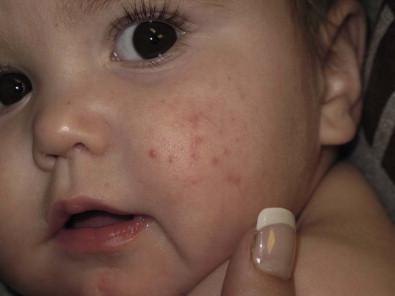
Acne and acne-like lesions have been reported from the use of several medications. Most notably, high dose systemic corticosteroids can cause an acneiform eruption in childhood. The lesions are characteristically monomorphous pink-red papules and pustules erupting on the face, chest, shoulders and upper back. Chloracne, most commonly reported due to industrial or incidental exposure to the toxic hydrocarbon, dioxin, can also cause acne in infants and children. Open comedones and small nodules predominate, often involving the malar region and ears, extending to involve the nape of the neck. The central face is spared. Other potential causes of medication-induced acne are listed in Box 25.1 .
Apert syndrome, or acrocephalosyndactyly, is characterized by craniosynostoses, midface hypoplasia and symmetric syndactyly of the bones of the hands and feet. Defects in skin, skeleton, brain, and visceral organs are commonly associated. Most cases are sporadic, but autosomal dominant and mosaic forms are reported. Apert syndrome is caused by a missense mutation in the fibroblast growth factor receptor-2 (FGFR2) gene that encodes the FGFR2 protein. Interestingly, somatic mutations in the FGFR2 gene have been found in several cases of mosaic nevus comedonicus (acneiform unilateral nevus). This growth factor protein is vital for numerous cell processes including cell division, growth regulation and maturation, formation of blood vessels, wound healing, embryonic development and malignancy. Patients with Apert syndrome develop pronounced seborrhea with atypical acne lesions, involving the forearms, buttocks and thighs early in puberty, but to date this has not been described in early infancy. The acneiform lesions are notably resistant to standard acne treatments and isotretinoin is often required to control the process.
Become a Clinical Tree membership for Full access and enjoy Unlimited articles
If you are a member. Log in here